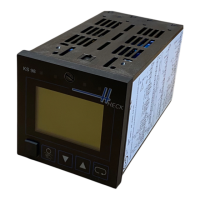24.5 Small controller ABC
Some operating principles, which are realized in the controller (d) or which are possible by means of an additional en
-
gineering are explained in the following section (ü). Cross references are shown in italics.
3
Anti-reset-wind-up
Measure which prevents the controller integrator from saturation.
3
Working point (Y0)
The working point ofaPoraPDcontroller indicates the value output to the process with process value = set-point. Al
-
though this value is only important for P and PD controller, it can also be of interest for controllers with integrator (au
-
tomatic working point).
3
Automatic operation
Normal controller operation. The controller controls the process by means of the adjusted control parameters. Auto
-
matic operation is effective with a/m (di7) set to 0 (automatic) AND automatic selected via front-panel key H AND
sm/hm (di16) set to 0 (soft manual). Contrary: manual operation.
3
Cutback
Reset of the integral action shortly before reaching the end setpoint with setpoint ramps.
3
Cycle time
The duration of a switching cycle (pulse and pause) at 50 % power control of a 2-point controller.
3
Line-out to the target
By early setpoint switch-over to the ramp end setpoint, the controller
is given a new target orientation for smooth line-out to the target.
ü Bandwidth control
With program control or gradient control, there may be a considerable control deviation if the process is slow. This can
be prevented by monitoring the control deviation for an adjusted tolerance band by means of additional function blocks.
With out-of-tolerance, the set-point change is stopped (w stop with controller or stop with program controller).
3
Three-element control
Particularly suitable for processes in which load changes would be detected too late (e.g. level control for steam boil
-
ers). In this case, a disturbance variable is used at which the mass balance (steam removal, feed water) is evaluated,
subtracted and added to the control variable (after differentiation, if necessary).
ü
Feed-forward control
Especially suitable for processes with long delay time, e.g. pH-control. A disturbance variable is used, at which the
evaluated, differentiated or delayed value of an analog input (YAdd) is added directly to the controller output for
avoiding the controller time behaviour.
3
Gradient control
Particularly suitable for processes in which energy shocks or quick set-point changes must be avoided. Set-point
changes are bumpless in both directions, since the effective set-point always runs towards the changed set-point (des
-
tination set-point) by means of gradients Grw+ or Grw-. For the second set-point w2, gradient Grw2 acts in both direc
-
tions, also with w r w2 switch-over.
3
Manual operation
When switching over to manual operation, the automatic sequence in the control loop is interrupted. Modes soft man
-
ual and hard manual are available. Switch-over automatic r manual and vice versa are bumpless. Manual operation is
effective with a/m (di7) set to 1 (manual) OR manual selected via front-panel key H OR sm/hm (di16) set to 1 (hard
manual). Contrary: automatic.
g
If automatic remains selected via key H, the controller changes to automatic after omission of the di7
signal. With manual selected additionally via key H, the controller remains in manual mode after
omission of the di7 signal.
Controller 9499 040 50611
Small controller ABC 164

